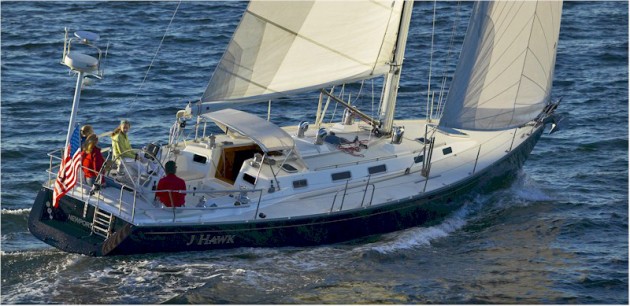Advertisement
Advertisement
Perry Design Review: J/44
Simple and fast for big boat racing
September 14, 2000
The Johnstone brothers have hit upon a very successful formula that might boil down to "keep it simple and keep it fast." The new J/44, designed by Rod Johnstone, due to be launched in May, is the logical extension of the J/35. It is designed to offer performance to suit the needs of the "serious offshore racers" and the cruiser. A J/44 one-design class has already been established.
We don't have an underwater profile of this design, but when I spoke to Stuart Johnstone he said, "It's just like the J/35." I think that's pretty easy to imagine. Let's see, a very clean canoe body line with a large planform fin-keel and deep spade rudder. There is no skeglet and no filleting around the keel root. The midsection, which I managed to capture, shows gentle deadrise of 10 degrees fairing into a relatively narrow BWL with plenty of flare to the topsides.
The J/44 is rated at 517 in 10 knots of breeze in the linear random mode of the IMS. You can compare this to a C&C 44 rating 544 and my own Nordic 44 rating 569. The J/44 has plenty of static stability and will need it to carry the big rig designed for it. The D/L ratio is 159.
J Boats will provide you with plenty of numbers and comparative data to evaluate the new 44. Keep in mind that if designing a good boat was simply a matter of aligning superior numbers, my job and every other yacht designer's job would be much easier. Sailing yachts are like stereo gear. You can study all the graphs and ratings, but in the end you will have to listen to the components in your own operating environment to truly evaluate the performance. Sailing yachts have a way of developing a character of personality that is not always predicated by hydrostatics. In this case, I trust the consistent design approach used by Rod Johnstone since the J/24 will produce a quick, stiff and tactically rewarding boat to sail.
This interior is near ideal for me. I would like to see a bigger galley, but that could be easily fixed with another four feet of LOA. You can fix a lot of things with more LOA, but that's seldom an option available in production yacht design. This layout is great for two couples and their kids or a modest-sized racing crew. Note the shower stall and double access to the head. You can wrap, bend, curve and angle all you want, but you won't find a more useable design for the dining area than the simple settee berths with a drop leaf table. I know it looks unimaginative, but it works and furthermore, it looks like a boat. The two aft double berth staterooms straddle the engine box and both have the option of an elevated pipeberth.
The deck of the 44 features a long T-cockpit divided by the traveler with a large diameter wheel piercing the sole. Side decks are very wide. There is no cockpit coaming at the helm station. Some will say, "What, no seatback?" but others know that sitting on the deck without a seatback provides the most comfortable position when sailing. The cockpit sole is wedged up each side to improve footing when heeled over. Considering the racing pedigree behind any J Boats product, you can take for granted that the desk layout will be honed to near perfection before the second boat is delivered.
The 44 is rigged as a sloop with sweptback triple spreaders. The J dimension is quite short, but the 54-foot I and the 19.4-foot E dimension boosts the sail area sufficiently to give a SA/D ratio of 23. Compare this to the C&C 44's 18.7 and the Nordic 44's 17.8. There are runners and checkstays leading to the transom.
J Boats products are always exciting because of the performance they promise. Personally, I would like to see some sweep in the sheerline. In the water this boat will appear to have no spring at all to the sheer. This keeps the 44 consistent with the rest of the J Boat fleet. IMS racers, be on guard.
Boat Specifications
| LOA | 44.5' |
| LWL | 38.7' |
| Beam | 13.7' |
| Draft | 8' |
| Displacement | 20,600 lbs. |
| Ballast | 9,000 lbs. |
| Sail Area | 1,040 sq. ft. |
| SA/D | 23 |
| D/L | 159 |
| Auxiliary | Yanmar 55 |
| Fuel | 40 gal. |
| Water | 120 gal. |
 This story originally appeared in Sailing Magazine, and is republished here by permission. Subscribe to Sailing.
This story originally appeared in Sailing Magazine, and is republished here by permission. Subscribe to Sailing.Advertisement
Related Boats for Sale
See more boats like thisAdvertisement


















